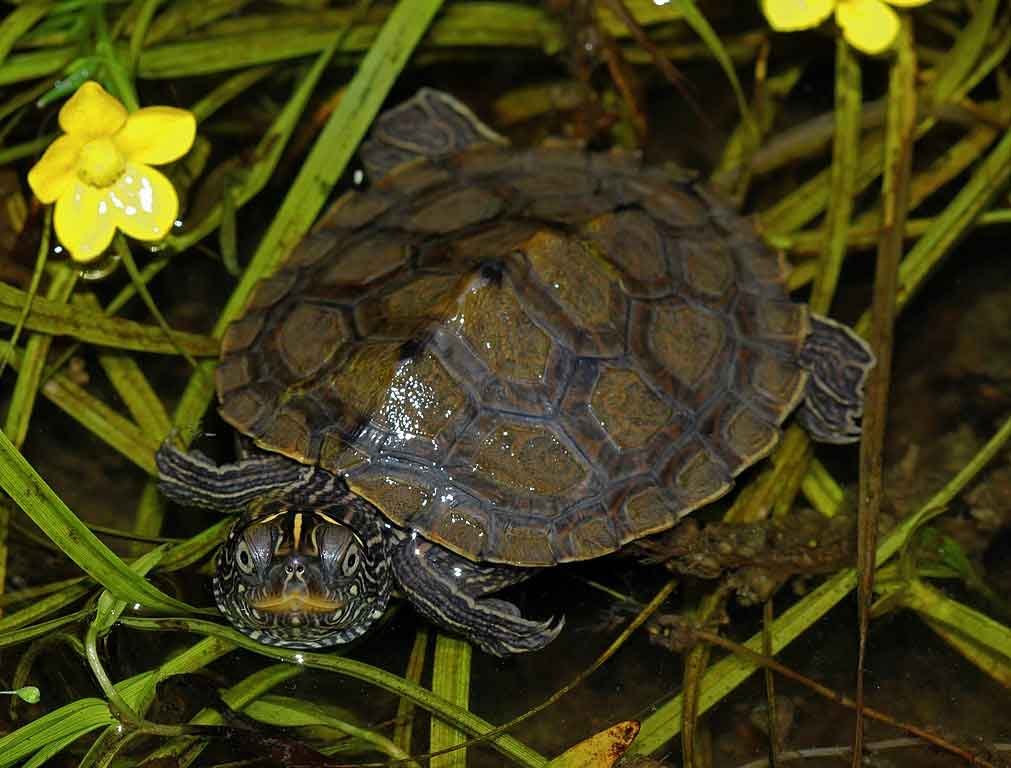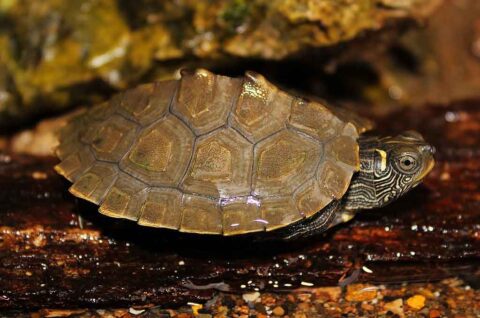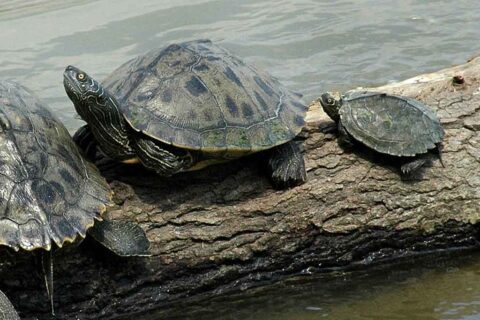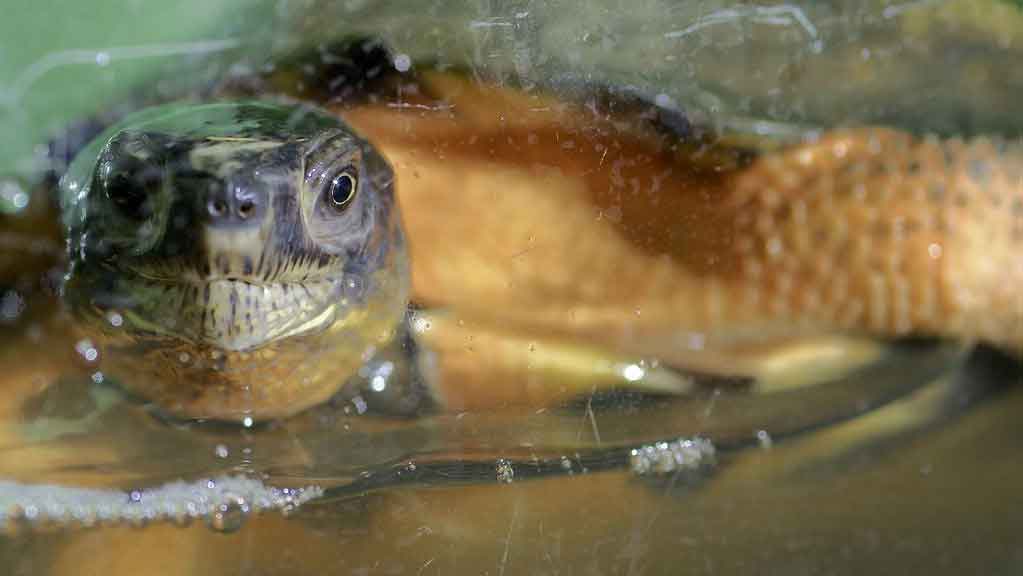
Content |
|---|
Origin / Distribution
The False map turtle and Mississippi map turtle belong to the same species, but they are different subspecies.
Gender: Graptemys (Map turtles)
Species: Graptemys pseudogeographica (False map turtle)
- Subspecies: Graptemys pseudogeographica pseudogeographica (False map turtle)
- Subspecies: Graptemys pseudogeographica kohnii (Mississippi map turtle)
The subspecies with which the species was originally described is called nominal form. In the case of the named form, the species name is used twice. In this case it is Graptemys pseudogeographica pseudogeographica, the False map turtle. The second subspecies is Graptemys pseudogeographica kohnii., the Mississippi map turtle.
The Map turtles they are sun worshipers
The False map turtle (Graptemys pseudogeographica), lives in large streams of the Missouri and Mississippi river systems, ranging from ohio, Indiana, Illinois, Wisconsin, Minnesota, through the Dakotas south to southwestern Alabama, southern and western Mississippi and Louisiana. The False map turtle also lives in various other river systems of southwestern Louisiana and eastern Texas.
Characteristics / Appearance
Unfortunately, the Map turtles not offered in pet stores neatly separated by species. They are mostly a mixture of Graptemys p. pseudogeographica, Graptemys p. kohnii and Graptemys ouachitensis. Estas Map turtles they are distinguished by the markings on their head. in the three, head markings consist of yellowish to ivory lines on a dark gray background.
The typical mix of Map turtles from the pet store
In the False map turtle (Graptemys pseudogeographica pseudogeographica) there are two slightly thicker stripes on the head behind the eyes, coming out of the nape and bending to the side behind the eye. Under the eyes and around the mouth there are many spots, but they are barely thicker than the stripes. A few stripes come out of the neck and reach the eye. The iris of the eye is light brown to beige in color and is cut horizontally by a black line. The beak is light to dark yellow.. Leg and neck lines are slightly finer in this subspecies than in the other two.
In the Mississippi map turtle (Graptemys pseudogeographica kohnii), two prominent lines also run from the neck towards the eye and bend there, but then they go much further and enclose the eye in the shape of a crescent or a sickle. The circular markings on the head are relatively small and occur almost exclusively on the chin. Neck stripes do not touch the eye, because there is already the drawing in the shape of a sickle around. The iris is white and only rarely has a dark line. The beak is colorless to whitish.. Leg and neck lines are evenly thick, with lighter and darker lines.

In the Ouachita map turtle (Graptemys ouachitensis) there are two yellow-orange spots on the head, behind the eyes, which are between oval and square. These spots have a dark border. From these points there are no lines towards the neck. under the eyes, under the corners of the mouth and on the chin, under the tip of the beak, there are circular marks, which are clearly larger than in the first two Map turtles. The diameter is clearly greater than the thickness of the neck lines. Starting from the neck, one to three lines reach the eye. The iris is white and usually has a thin black line that crosses it horizontally.. The beak is colorless to whitish.. In the Ouachita map turtle adults the lines are usually reddish, instead of yellowish, but not always. In the lines of the legs and neck, light and dark lines are of different thickness.
Size and weight of the “Map turtles”
Females can reach up to 27 cm of shell length. The males are still pleasantly small, with a maximum of 15 cm.. Adult females usually measure between 21 and 25 cm and weigh between 1,1 and 1,8 kg. The adult males of Graptemys pseudogeographica they are smaller, of 11 to 15 cm., and also weigh only 140-370 g.
Males are still much smaller than females.
The Ouachita map turtle (Graptemys pseudogeographica kohnii) must remain minimally smaller than the False map turtle (Graptemys pseudogeographica pseudogeographica)
Habitat
The Map turtles are typical inhabitants of large rivers, but they also live in lakes and ponds. They prefer waters with abundant underwater plants, lots of sunbathing spots and shallow streams.
Behavior
The False map turtle is a strong swimmer and prefers rivers and large streams with moderate currents, containing aquatic vegetation, as well as floating logs. It is also comfortable in deep and fast water. Turtles are present in the elbow lakes and in the swamps, but they are absent from the lakes, ponds or small streams. Rest is important for these turtles, and can even be found on steep and slippery logs.
Food
Food components of the females of Map turtles in the nature (according to LINDEMAN 2013):
- Molluscs 22 %
- Fish 6 %
- Caddisfly larvae 2 %.
- May flies 11 %
- Dragonflies 0,4%.
- Plants 55 %
- Other 4 %
According to VOGT (1981), the 42 % of the diet of adult females Graptemys pseudogeographica consists of plants (Vallisneria, Potamogeton, Lemna and algae), followed by molluscs and flies. While the males feed mainly on insects and do not eat plants.
Sex determination
In the Map turtles, the claws on the front feet are not a reliable feature to distinguish between the sexes. To distinguish males from females, the Map turtles must have a carapace length of at least 10 cm.. Prior to that, all look like females.
In the Map turtles male, the tail is much longer and also somewhat thicker. They are said to have a “fifth leg”. The cloaca is situated well outside the shell when the tail is extended.. In females the tail is relatively short.. The cloaca is approximately level with the edge of the carapace when the tail is extended..
Reproduction

Males reach sexual maturity at 7-9 carapace length cm. Females reach sexual maturity much later, to the 18 carapace length cm. Mating can take place in the fall or spring.. After a single mating, females lay one to four clutches per season. Each nest consists of 2 to 22 eggs. The number of eggs per clutch in the Graptemys p. pseudogeographica is usually greater than Graptemys p. kohnii.
The higher the incubation temperature, more shell abnormalities hatchlings will have.
The incubation temperature can be between 25 and 32 °C. If you want more male offspring, hatching temperature of 25 °C. But, to 30 °C, more females are born. The warmer the incubation, the quicker the little turtles will be born. It usually takes between 50 and 80 days.
Threats to the species
State of conservation ⓘ |
||
|---|---|---|
 Minor Concern ⓘ
(UICN)ⓘ
Minor Concern ⓘ
(UICN)ⓘ
| ||
This species faces several threats, such as destruction of egg nests by animals and insects, falling into gillnets and shooting. The False map turtle, like the Red-eared slider (Trachemys scripta elegans), have also been collected for the pet trade.
All Map turtles are included in CITES Appendix III and in Appendix C of the EU Species Protection Regulation. But, they do not need any documents when trading within the EU and are not subject to declaration.
The "False map turtle" in captivity
Aquaterrarium
The Map turtles It is native to large rivers and lives in areas of slow flow.. Thus, they need an aquarium with plenty of room to swim. For one or three adult females, should have 160 x 60 x 60 cm and a water level of 40-50 cm.. Of course, can also be higher. The Map turtles male is still much smaller, can be kept very well in an aquarium of dimensions 100 x 40 x 50 cm., that is to say, a standard aquarium of 200 litres. for the pups, the aquarium can be smaller at first. If you buy pups from a pet store or breeder, I would start with an aquarium of at least 80 cm to avoid having to buy new aquariums.
Aquaterrarium decoration
The assembly of aquaterrarium can be simple, because the Map turtles they mostly need space to swim. A thin layer of sand or other substrate can be placed on the bottom. You can create some structure with a few roots or pretty stones. A cave is also popular with Map turtles, for example, halved clay pots or a wall-mounted terracotta pot are suitable.
Planting in the aquarium is difficult. females eat plants. Males eat fewer aquatic plants, so you can try. But the males also burrow into the substrate, so it is not worth planting them. But, you can try plants that float freely in the water, as the Anthocerotophyta and Elodea. Basically, all aquatic plants that occur as food plants are suitable for planting.
Clean water is immensely important to the Map turtles. So, good filters are recommended. The water should also be changed regularly.
Terrestrial part
The Map turtles they have sensitive shells. So, the land part should not be made of stones. Wood in any form is much more suitable. For young turtles and males, just an area of land made with a willow or cork bridge.
Sexually mature females need the opportunity to lay eggs.. Females that have never had contact with a male can also form eggs and should be given the opportunity to lay them on land.. Otherwise, there is a risk that eggs will be laid. Turtles do not lay their eggs in the water., but they bury them in the ground. The egg-laying area for Map turtles must have a minimum area of 50 x 30 cm and a substrate height of 30 cm..
Illumination
The Map turtles they are hungry for light. They need high-quality lighting. A Map turtles will not be happy with cheap lamps and a fluorescent tube. The only sensible lighting for these tortoises is a metal halide lamp with a UV component. (also abbreviated as hqi). These lamps are not only very bright, they also provide the vital UV-B light that is necessary for the formation of vitamin D. They also get very hot, so it can be achieved 40-45 °C required on land if the distance is adequate.
for the juniors, is enough a hqi of 35 watts, for example the SolarRaptor HID Lamp Set incl. ECG + ClampLamp* or the Exo Terra Sun Ray Lighting Complete Set*. For females it should be a lamp 70 watts, I recommend the following complete set: Lucky Reptile Bright Sun Set Turtle*.
Food
If the diet in the wild is known, food is actually quite simple. The Map turtles they can also eat all this in the aquarium. Use brown shrimp and other dry foods such as water fleas and mosquito larvae as a staple. It also, the Map turtles they are happy to eat frozen food, like red mosquito larvae and mussels. Mussels belong to the molluscs and are also widely eaten in the wild. the living food, like earthworms and isopods, should also be on the menu regularly.
The Map turtles they eat in the water, just throw the food in the water!
The proportion of vegetable food must be at least 40 % for the females of Map turtles. algae and aquatic plants (for example, duckweed) are particularly suitable for it. If you don't have enough aquatic plants, dandelions and other wild herbs are a good alternative. Otherwise, it is also possible to feed them with lettuce. Males and youngsters should also be offered plants regularly. The young also eat plants. The adult males of the Map turtles they barely eat them.
Yes the Map turtles do not accept plants well (especially the males), you can also occasionally use the pellets Sera’s Turtle Adult Nature* to provide crude fiber. These duckweed pellets contain more crude fiber than other terrapin sticks.
The Map turtles are very prone to vitamin A deficiency. To avoid this, you have to give them grated carrot once a week.
While young animals can be fed once a day during their first year of life, the Map turtles Older animals should only be fed pet food or pellets three to four times a week.. Otherwise, turtles will grow too fast. The amount of food should be such that it is finished after 10 minutes. Plants must always be available, a tortoise can eat whatever it wants.
For calcium supply, a piece of cuttlefish must always be floating in the water.
Temperature and hibernation

The two subspecies of Graptemys pseudogeographica have a wide distribution area. The False map turtle (Graptemys p. pseudogeographica) is further north, so it must hibernate a 4-8 °C for five months. The Mississippi map turtle (Graptemys p. kohnii) inhabits southern part of range. Thus, only hibernates for three months 10-15 °C.
Aquaterrarium with several turtles
The Map turtles, like all aquatic turtles, they are actually solitary animals. So, keep one Map turtles is appropriate for the species and recommended. But, if you want to keep several turtles together, all must be female. females get along better. Groups of three or more animals work very well.
When keeping a group, it should always be possible to remove a turtle from the group in case of stress or bite.
The Map turtles male should be kept separate from females. Otherwise, their constant mating attempts will make the females too nervous. The males of the Map turtles are often surprisingly compatible with each other, and it is often possible to keep several males together.
keep at Map turtles in a pond
The Map turtles not usually suitable for keeping in a garden pond. It's just too cold for them and the sunshine period is too short.. This leads first to shell necrosis and then to liver and kidney problems.. if you want to have Map turtles in a pond, the northernmost subspecies in particular is reasonably possible. It's about the False map turtle (Graptemys p. pseudogeographica).
Buy one "False map turtle"
The price of a "False map turtle" at the exotic animal market, ranges between 30 – 70 EUR
Videos "False map turtle"
|
|
|
|---|
Alternative names:
1. False map turtle, Sawback (English).
2. Fausse tortue géographique (French).
3. Falsche Landkarten-Höckerschildkröte, Falsche Landkartenschildkröte (German).
4. Falsa Tartaruga Corcunda (Portuguese).
5. "Tortuga falso mapa", Falsa Tortuga Mapa (español).
Sources:
Ernst, C. H. & J. E. Lovich (2009): Turtles of the United States and Canada – Second Edition. – The John Hopkins University Press (Baltimore): 827 pp.
Gibbons, J. W. & J. E. Lovich (1990): Sexual dimorphism in turtles with emphasis on the slider turtle (Trachemys scripta). – Herpetol. Monogr. (4): S. 1-29.
Lindeman, P. V. (2013): Map Turtle and Sawback Atlas – Ecology, evolution, distribution and conservation. – University of Oklahoma Press (Norman), 460 p.*.
Vogt, R. C. (1981): Food partitioning in three sympatric species of map turtles, genus Graptemys (Testudinata, Emydidae). – American Midland Naturalist (105): pp. 102-111.

